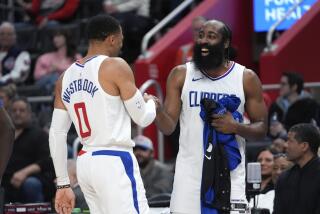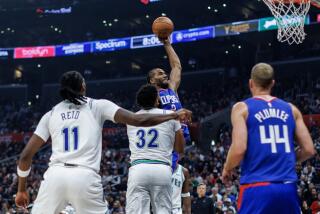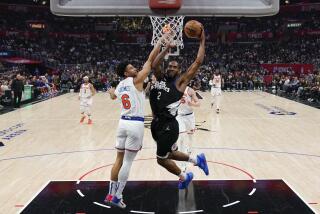Olowokandi Is Making Big Strides
- Share via
He was once languid, but now he’s driven. He was awkward; now he’s smooth. He was timid; now he’s fearless. He was an afterthought; now he’s a go-to guy. He was booed; now he’s cheered.
Perhaps the day Clipper center Michael Olowokandi’s game changed coincided with the day his life changed.
Arrested in the early-morning hours of Dec. 1 after a scuffle with a former girlfriend, Olowokandi spent the rest of the night in the Manhattan Beach jail. The Los Angeles County district attorney declined some weeks later to file charges against him, but the experience was difficult for him.
“Obviously, it alters who you are to a certain extent,” said Olowokandi, 26, who stands 7 feet and weighs 270 pounds. “It was an unfortunate situation. I’m still friendly, cordial with her. She didn’t use good judgment. She said things to the police to get at me. Did it change my perception of people? I can’t let things change who I am. I guess I should be more careful with people. I am a trusting person by nature.
“I’d hate to be in a position that when basketball is over I’ve become a changed person, that I’m not a fun-loving person.”
It has been obvious to longtime observers of Olowokandi that he has become more assertive on the basketball court since his arrest. He appears to be more willing to stand up for himself.
Olowokandi got into an altercation with Shaquille O’Neal in the closing moments of the Clippers’ loss March 15 to the Lakers, then suggested to reporters that O’Neal “needs to grow up.” He became so angry at a referee’s decision in Tuesday’s loss to the Sacramento Kings that he kicked the ball the length of the court, drawing a technical foul. He also has become more of a floor leader, taking his teammates to task for all manner of transgressions.
“It’s truly a remarkable turnaround,” said Bill Walton, a TV commentator and former NBA standout. “Here’s a guy who didn’t seem all that interested in playing basketball, much less being a top player. Industriousness and enthusiasm, two cornerstones of John Wooden’s ‘Pyramid of Success,’ were two traits that I didn’t associate with Michael Olowokandi.”
Consider that Olowokandi had only seven 20-point games during his first 31/2 seasons in the NBA but has eight since Jan. 28, including a career-best 30 points in a March 8 victory over the Chicago Bulls. He is averaging 16.2 points and 10.8 rebounds in 13 games this month. His overall averages this season are 10.2 points and nine rebounds.
Question is, has Olowokandi’s metamorphosis from “robotic stiff,” in the words of Walton, to “showing his competitive fire” (Walton again) ensured his swift departure from the Clippers? Will he be too good to keep beyond this season or next?
There has been much speculation about Olowokandi’s future in recent weeks and there’s certain to be more. If he’s not signed to an extension, he’ll be a restricted free agent July 1, with the Clippers able to match any outside offer.
Olowokandi said last week that he has heard nothing from his agent, Bill Duffy, or Clipper management about a new contract. But he’s not worried--at least not yet.
Certainly, it wouldn’t be the first time a professional athlete was motivated to improve his play because he sought the security of a bigger and better deal.
But Olowokandi insisted he is focused on a game he is only now, in his seventh season of organized play, beginning to master. He’s leaving the contractual matters to his agent.
Besides, the Clippers are locked in their first playoff chase since 1996-97, and as remarkable as it sounds, Olowokandi is helping to lead them. Anyone who has seen Olowokandi wheel and deal on the low block in the last few weeks has been impressed.
“I thought Olowokandi was incredible,” San Antonio Coach Gregg Popovich said after watching him score 26 points and take 17 rebounds in the Spurs’ victory over the Clippers on Monday. “He definitely was all over the floor. He really kept us honest down there and really made a game of it.”
Walton thought so much of Olowokandi’s play that he sought him out after the game to offer a few kind words. “I told him, ‘Michael, congratulations, you’ve become a real basketball player,’” Walton said.
Clipper forward Corey Maggette put it another way: “I feel Michael Olowokandi has improved 300% from where he started. He has become a dominant big man. The sky is the limit for him. But they still need to pay him that money.”
In many ways, Olowokandi is a test case for just how serious the Clippers are about keeping perhaps the NBA’s best young team together until it fulfills its potential. Olowokandi’s growing presence in the middle has allowed All-Star Elton Brand to concentrate on his more natural position, power forward. Brand already has said that his future with the team is tied to Olowokandi’s.
Clipper General Manager Elgin Baylor wants to keep Olowokandi in the fold.
“He’s vital to the future of this franchise,” Baylor said. “He’s getting better and better all the time. I think he will be one of the top five centers in this league.”
Clipper Coach Alvin Gentry made his wishes clear earlier this week, when he said, “Obviously, I’d like for the whole team to stay together. My recommendation would be to keep them all together. You’ve got a big guy, a pretty good center who has a chance to become a very good center. He’s working toward that.
“You’ve got to keep guys like that around.”
In order to appreciate how far Olowokandi has come, it’s important to know how and where his basketball career began.
He was 17 and living in London when he touched a basketball for the first time. It was tucked away in the back of his high school’s athletic equipment room, behind the soccer and rugby balls and cricket bats you would expect to find in his native England.
“I played basketball because it was something different,” he said. “It was something I always wanted to do.”
Until that day, Olowokandi had been a soccer player and a long- and triple-jumper. He was soon hooked on basketball, dominating schoolmates during pick-up games in which double-dribbling was as commonplace as a swished 15-foot jump shot.
On his 20th birthday, Olowokandi opened a book of U.S. colleges and picked the University of the Pacific at random. With no thoughts of attending the school, but merely interested in learning about transferring, he picked up the phone and spoke to Tiger assistant Tony Marcopolos.
Bob Thomason, Pacific head coach, had jokingly told his assistants they should never leave the office unattended “because you never know when a 7-footer would walk through the door.” And here was one on the telephone.
Olowokandi was sold on Pacific in minutes, offering to attend the school without a basketball scholarship. In fact, he didn’t get one until right before his senior season.
“I went from London, trendy and sophisticated, to Stockton, which is pretty rural, and you can imagine what that was like,” Olowokandi said. “Maybe it was what I needed to focus on basketball.”
As a sophomore, Olowokandi played only at the end of one-sided games. He didn’t know the rules. He had natural ability, but the skills honed by other collegiate players over the years were sadly lacking. As a junior, he was injured for part of the season.
As a senior, he finally began to show signs of being the player he would become, averaging 22.2 points and 11.2 rebounds and earning Big West Conference player-of-the-year honors. The Clippers made him the top pick in the 1998 draft, taking heat for a selection every other team probably would have made if in the same position.
After three seasons, it seemed to outsiders that the Clippers could live without Olowokandi just fine if 2001-02 were like his previous seasons. Lamar Odom was considered their best player and they had acquired Brand from the Bulls.
The Clippers felt differently and tried, but failed, to work out an extension during training camp last October. In the end, both sides were willing to wait to see if Olowokandi could improve on his three-season averages of 9.1 points and 7.4 rebounds.
The Clippers were hopeful a breakout season was at hand, but they also challenged him to excel at every opportunity.
Baylor, perhaps Olowokandi’s biggest supporter, had seen the player improve during practices and offered this advice: “Do that in the games.”
Igor Kokoskov, who became an assistant to Gentry before last season, approached Olowokandi upon meeting him for the first time and said, “I’ve seen you play and I’m not impressed, given your natural ability.”
Said Olowokandi: “I didn’t like hearing that.”
Gentry turned Kokoskov loose on Olowokandi, instructing him to improve the big man’s footwork while also diversifying his shot selection. They spent hours in the gym, Olowokandi setting up for jumpers and hook shots in and around the paint while Kokoskov rebounded and fed pass after pass to him.
“You have to be patient with big guys,” Kokoskov said. “I could see he was capable of doing so many things, but I’m never satisfied.”
Something finally clicked.
“It’s something I always thought I could do, but for some reason I didn’t,” Olowokandi said. “This season I have more of an offensive array. I’m more successful at it because I’m more confident doing it. There are things I’m doing now in games that I never thought I would do last season.”
More to Read
Get our high school sports newsletter
Prep Rally is devoted to the SoCal high school sports experience, bringing you scores, stories and a behind-the-scenes look at what makes prep sports so popular.
You may occasionally receive promotional content from the Los Angeles Times.






